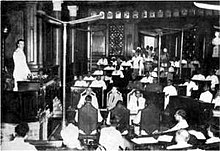Chamber of Princes
The Chamber of Princes (German: Kammer der Fürsten; Hindi: Narendra Mandal or Narender Mandal ) was created as an advisory body in British India as part of the Montagu-Chelmsford reforms, which resulted in the Government of India Act 1919 . Already under the viceroys Lytton and George Curzon there had been proposals to give the princes a certain say. These proposals had been rejected by London.
history
Members were the adult rulers of the 108 Indian princely states , which had been granted the right to eleven or more rounds of salute . A further twelve members were selected from a group of 127 rulers of smaller states. 327 small states were not represented in the chamber. The work in the chamber was not very attractive for the princes of the more important states, as they had the possibility of direct influence.
They met once a year. The inaugural session on Feb. 8, 1921, was presided over by the Duke of Connaught . The viceroy presided, in his absence the chancellor elected from among the princes. The principle of 1 state = 1 vote applied, which over the years led to the withdrawal of the largest states because they did not see their interests sufficiently represented. The longest meeting, which was also the one with the most participants, namely 60, lasted ten days in 1932. In the meantime, business was conducted by a standing committee , which was elected annually and was chaired by the Chancellor ( Chancellor ) .
In 1930, when Congress no longer took part in the round table on constitutional reform, the Standing Committee became the most important forum for conservative Indian interests within the existing colonial system. However, they soon fell out over the composition of the Indian States delegation that was sent to London. The three meetings in London then also came to nothing.
Louis Mountbatten, 1st Viscount Mountbatten of Burma, advised the princes of India to join in a speech to the Chamber on July 20, 1947. With the independence and partition of India on August 15, the chamber lost its right to exist. The last princely states were dissolved during the administrative reorganization in 1956.
Chancellor

- Ganga Singh , Maharajah of Bikaner : 1921–1926
- Maharajah Adhiraj Bhupinder Singh , Maharajah of Patiala : 1926–1931, 1933
- KS Ranjitsinhji , Maharajah of Nawanagar : 1931-1937
- KS Digvijaysinhji, Maharajah of Nawanagar: 1937-1944
- Hamidullah Khan , Nawab of Bhopal : 1944 - June 3, 1947 (resigned as he planned to lead his state towards independence)
- Maharajah of Patiala, June 3, 1947-end
literature
- Rajeshwar P. Bhargava: The Chamber of Princes. Northern Book Center, New Delhi 1991, ISBN 81-7211-005-7 .
- Surinder M. Verma: Chamber of Princes. (1921-1947). National Book Organization, New Delhi 1990, ISBN 81-85135-44-4 .
- Barbara N. Ramusack: The Princes of India in the Twilight of Empire. Dissolution of a Patron-Client System, 1914-1939. Ohio State University Press, Columbus OH 1978, ISBN 0-8142-0272-1 .
- Individual evidence
- ↑ cf. List of Indian princely states
- ↑ Barbara N. Ramusack: The Indian Princes and Their States (= The New Cambridge History of India. 3 . The Indian Empire and the Beginnings of Modern 6). Cambridge University Press, Cambridge et al. 2004, ISBN 0-521-26727-7 , pp. 245-274: Chapter 8: Federation or integration? doi : 10.1017 / CHOL9780521267274.009 .
- ↑ Biography of the Rajas (1930s): Satadru Sen: Migrant Races. Empire, Identity, and KS Ranjitsinhji. Manchester University Press, Manchester et al. 2004, ISBN 0-7190-6926-2 .
See also
- Indian nobility predicates
- List of Indian princely states , with salute

